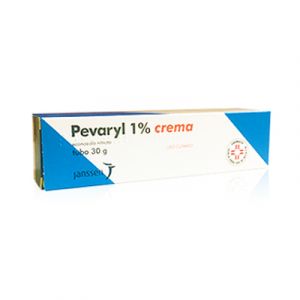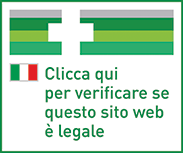Ship in Europe, Find out rates!

Pevaryl 1% Econazole Nitrate Antifungal Skin Cream 30 g
JANSSEN CILAG
Skin cream is a drug based on econazole nitrate .
Therapeutic indications
Pevaryl Crema 1% is used in the treatment of cutaneous mycoses caused by dermatophytes, yeasts and molds, skin infections caused by Gram-positive bacteria: streptococci and staphylococci, fungal otitis externa, mycosis of the ear canal (limited to the Cream form), onychomycosis and Pityriasis Versicolor.
Dosage and posology
Pevaryl Cream 1% must be applied morning and evening, in the infected skin areas, with a light massage, until the mycosis has completely disappeared (1-3 weeks). It is advisable to continue the application of Pevaryl for a few days after the disappearance of the mycosis. Intertriginous spaces (e.g. interdigital spaces of the foot, folds of the buttocks) in the wet stage should be cleansed with gauze prior to applying Pevaryl. An occlusive dressing is recommended in the treatment of onychomycosis.
Overdose
The pharmaceutical forms available are intended for topical application only. In case of accidental ingestion, nausea, vomiting and diarrhea may occur and should be treated with symptomatic therapy. If the product accidentally comes into contact with the eyes, wash with clean water or physiological solution and seek medical attention if symptoms persist.
Contraindications
Hypersensitivity to the active substance or to any of the excipients.
Side effects
The safety of econazole nitrate cream (1%) and econazole nitrate emulsion (1%) was evaluated in 12 clinical studies involving 470 subjects, who received administration of at least one of the formulations. Based on the safety data collected from these clinical studies, the most commonly reported adverse drug reactions (ADRs) (incidence ≥ 1%), were (with incidence%): pruritus (1.3%), burning sensation of the skin (1.3%) and pain (1.1%). The ADRs reported with the use of PEVARYL dermatological formulations both in clinical studies, including the adverse reactions listed above, and in post-marketing experience are listed below. Frequencies are reported according to the following convention: Very common (≥ 1/10); Common (≥ 1/100, <1/10); Uncommon (≥ 1 / 1,000 to <1/100); Rare (≥ 1 / 10,000, <1 / 1,000); Very rare (<1 / 10,000), Not known (cannot be estimated from the available data).
In the table below, which lists the adverse reactions of the dermatological formulations of Pevaryl, all ADRs with a known incidence (common or uncommon) are from clinical trial data and all adverse reactions with an unknown incidence come from post-marketing data.
- Disorders of the immune system
- Not known: hypersensitivity
- Skin and subcutaneous tissue disorders
- Common: itching, burning sensation of the skin
- Uncommon: erythema
- Not known: angioedema, contact dermatitis, rash, urticaria, blistering, skin exfoliation
- General disorders and administration site conditions
- Common: pain
- Uncommon: malaise, swelling
The use of products for topical use, especially if prolonged, can give rise to sensitization phenomena. In case of hypersensitivity reactions it is necessary to interrupt the treatment and institute a suitable therapy.
Pregnancy and breastfeeding
- Pregnancy
In animal studies econazole nitrate did not show teratogenic effects but did show foetotoxic effects in rodents at maternal subcutaneous doses of 20 mg / kg / day and maternal oral doses of 10 mg / kg / day. The relevance of this effect in humans is unknown. In humans, after topical application to intact skin, the systemic absorption of econazole is poor (<10%). There are no adequate and controlled studies, nor epidemiological data, on the undesirable effects resulting from the use of Pevaryl in pregnancy. In post-marketing studies, no adverse effects on pregnancy or on the health of the fetus and newborn were reported due to Pevaryl. Due to systemic absorption, Pevaryl should not be used during the first trimester of pregnancy unless the doctor considers it necessary for the patient's health. Pevaryl can be used during the second and third trimester of pregnancy if the potential benefit to the mother outweighs the possible risks to the fetus.
- Feeding time
After oral administration of econazole nitrate to lactating rats, econazole and / or its metabolites were excreted in breast milk and detected in pups. It is unknown whether dermal administration of Pevaryl can result in sufficient systemic absorption of econazole to produce detectable concentrations of econazole in human breast milk. Caution should be exercised when Pevaryl is administered to breastfeeding women.
Special warnings
All pharmaceutical forms of Pevaryl are indicated for external use only. Pevaryl is not for ophthalmic or oral use. In case of sensitization or irritation reaction, discontinue use of the product. Econazole nitrate powder contains talc. Avoid inhalation to prevent irritation of the airways, especially in children and infants.
Pevaryl contains butylated hydroxyanisole. It can cause local skin reactions (e.g. contact dermatitis) or irritation of the eyes and mucous membranes. Pevaryl contains benzoic acid. Slightly irritating to the skin, eyes and mucous membranes. Pevaryl contains propylene glycol. It can cause skin irritation.
Expiry and retention
Check the expiration date indicated on the package. The expiry date indicated on the package refers to the product in intact packaging, correctly stored. Store at a temperature not exceeding 25 ° C.
Warning : do not use the medicine after the expiry date indicated on the package.
Composition
100 gr of Pevaryl Cream 1% contain:
Active principle
Econazole nitrate 1.0 g.
Excipients
Blend of stearic acid esters with glycols; mixture of fatty acids with polyethylene glycol; Vaseline oil; butylated hydroxyanisole; perfume 4074; benzoic acid; purified water.
| Destination | Cost | Detail |
|---|---|---|
| Italy | €5,90* | 24/72H |
| Austria, France, Germany, Slovenia | € 13* | 3 days |
| Belgium, Luxembourg, Portugal, Netherlands, Spain | € 14* | 4 days |
| Bulgary, Cechia, Hungary, Poland, Romania, Slovakia | € 19* | 5 days |
| Denmark, Estonia, Finland, Ireland, Lithuania, Latvia ,Sweden | € 22* | 5 days |
| United Kingdom, Switzerland, Greece | € 30* | 7 days |
| Canada, USA | € 40 | 7 Days |
European shipments with express courier: FedEx, MBE, DHL
*For the shipment outside band B ther's an extra cost of 22€ *For the shipment outside band C ther's an extra cost of 30€ Delivery Times exclude Saturday and Holidays
For Islands and Areas of difficult Accessibility the shipments are made in 72 hours and the cost will be increased by 15€
